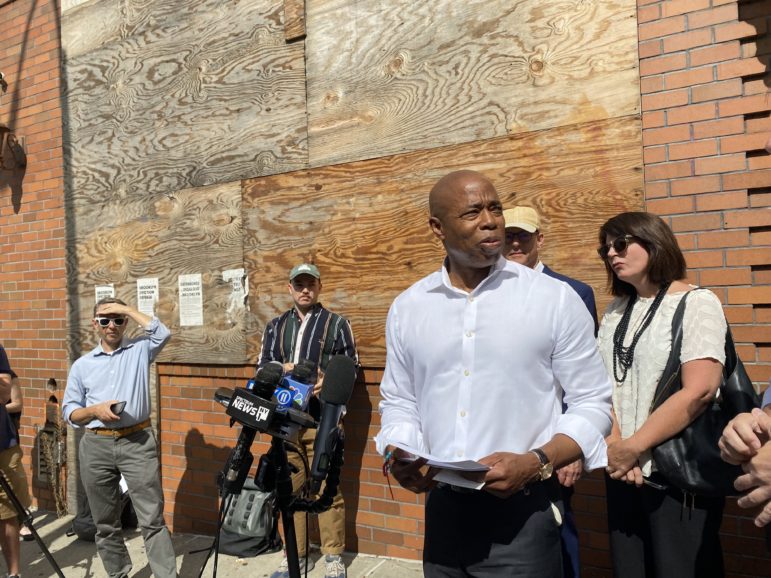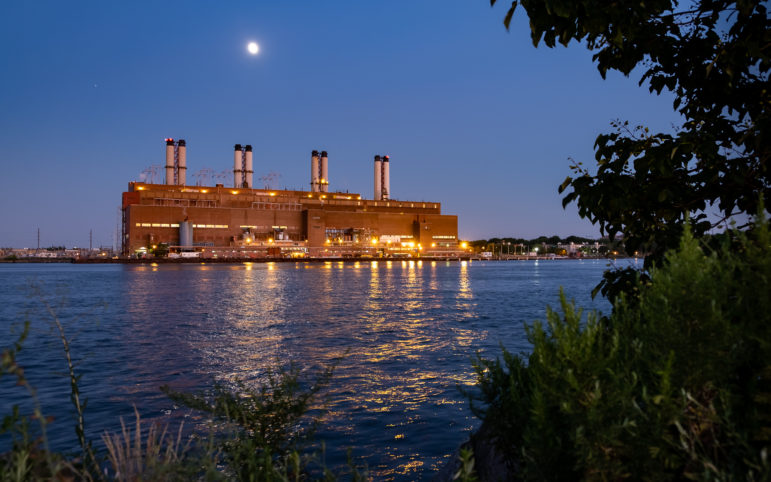What exactly did state lawmakers do before starting their nearly seven-month break? Here’s a rundown.

Darren McGee/Office of Gov. Kathy Hochul
The Capitol building in Albany.
New York’s lawmakers wrapped up their work for the year on Saturday by passing a slew of bills aimed at strengthening policies being targeted elsewhere in the country, including measures to shore up abortion access, limit assault-style weapons and expand voting rights.
Those issues dominated the final days of the New York legislative session, as lawmakers across the state now focus on newly contentious primary elections in redrawn districts. But the end of session also featured a focus on housing, with mixed results amid an ongoing affordability crisis.
The Assembly and Senate both approved a bill to restructure and raise capital for thousands of ailing public housing units in New York City and another to ease the process for converting hotels to permanent apartments. The two measures were among Mayor Eric Adams’ top priorities in Albany.
More notable, perhaps, are the housing bills that died and will likely be the focus of intense activity next session. Facing backlash from real estate groups and property owners, state lawmakers failed to pass “Good Cause” legislation that would protect tenants in non-rent stabilized apartments from no-cause evictions and unjustified rent hikes. On the flip side, progressive resistance helped kill a revised version of a major tax break for developers known as 421a. A rumored compromise to pass both bills never materialized.
A few New York City education bills passed as well. Lawmakers voted to extend mayoral control of public schools for another two years while limiting class size in the five boroughs.
When it comes to climate legislation, lawmakers failed to act on two major bills championed by environmentalists—one to ban gas hookups in future construction statewide, and another that would require the state’s power authority to implement renewable energy projects.
So what exactly did state lawmakers do before starting their nearly seven-month break? Here’s a rundown:
Reshaping NYCHA through a public trust
Both chambers of the state legislature approved a measure that could shape the future for New Yorkers in 25,000 NYCHA apartments, despite resistance from many tenant leaders.
The legislation will allow NYCHA to move thousands of units into a publicly-owned Public Housing Preservation Trust with the power to issue bonds and borrow money for addressing desperately-needed capital repairs, so long as tenants vote to approve the transfer.
The Trust would convert the federal funding mechanism for each unit from a public housing operating fund known as Section 9 to Section 8 rental assistance vouchers, which come with more money from the federal government.
The plan has been billed as a “public option” in contrast to the ongoing conversion to private management at dozens of NYCHA campuses under the Rental Assistance Demonstration-Permanent Affordability Commitment Together (RAD-PACT) model. But the erosion of Section 9 public housing and questions over the exact threshold for the tenant opt-in vote and potential for privatization raised concerns among tenants and some lawmakers.
In the end, however, a pragmatic approach won out: With no money forthcoming for NYCHA’s $40 billion in repair needs, even progressive and some socialist electeds backed the Trust plan.
Gov. Kathy Hochul immediately declared her intention to sign the Trust into law.
“This is a major win for New Yorkers who call NYCHA home,” Hochul said. “This legislation has the power to unlock additional federal funding and lead to billions of dollars in renovations—after decades of federal disinvestment—and provide for critical improvements at developments across the city.”
Easing hotel conversions
Heading into the end of the last year’s legislative session, state lawmakers considered legislation called the Housing Our Neighbors with Dignity Act (HONDA) intended to fund or finance the conversion of unused hotels into desperately needed apartments for homeless New Yorkers.
As negotiations dragged on, City Limits asked the question: “Will New York actually seize an opportunity to purchase unused hotels and convert them into permanent affordable housing?”
Well, the Senate and Assembly passed the bill. But a year later, the answer to that question is still no. Not a single hotel in New York City has undergone conversion to permanent supportive or affordable housing with financing through HONDA.
The problem was zoning: too few hotels could be converted as-of-right. This time around, lawmakers passed a measure to ease that process by making more hotels eligible near residential communities without obtaining a new certificate of occupancy.
“This legislation is essential to fast-tracking the creation of desperately needed housing across our state,” said Tracie Adams, a leader with the organization VOCAL-NY.
Assembly sponsor Steven Cymbrowitz said the revision “creates an important tool to allow hotel rooms to be converted to permanent housing in a city desperately lacking in supportive and affordable housing stock.”

David Brand
Eric Adams last year, announcing his plan to convert struggling hotels into homeless housing.
Bad news for Good Cause
The top priority for many tenants’ rights advocates withered as the legislative session came to a close. The “Good Cause” bill would have given tenants in non-regulated apartments the right to a lease renewal in most cases while preventing landlords from removing a tenant without an order from a judge, even if the renter did not have a lease. The bill would have allowed tenants the ability to challenge rent increases of 3 percent or more, forcing landlords to justify the additional costs.
Advocates and progressive lawmakers said the legislation was a crucial intervention to protect tenants from skyrocketing rents and abrupt evictions. But the bill faced opposition from the real estate industry and moderate lawmakers, particularly in areas with many homeowners. Good Cause never gained public support from Assembly Speaker Carl Heastie or Senate Majority Leader Andrea Stewart Cousins.
Cea Weaver, the campaign coordinator for the statewide tenant group Housing Justice For All, called the legislature’s aversion to Good Cause a “moral failure.”
“State lawmakers will go back to safe and healthy homes in their district. They’ll fall asleep soundly in their beds, secure in the knowledge that they and their families will have a roof over their heads for the foreseeable future,” Weaver said. “Meanwhile, hundreds of thousands of New Yorkers will be up late, terrified that they’ll face a rent hike so high it will amount to an eviction.”
Landlord groups, in contrast, hailed the halt to Good Cause.
“New York is by far the most expensive state in the country to operate rental housing,” said Jay Martin, the executive director of the Community Housing Improvement Program, which represents property owners. “Instead of adding further regulations that will drive up the cost of housing, lawmakers should be finding ways to make building and operating housing less expensive.”
One thing is for sure: rising rents aren’t going away. Expect to see Good Cause among tenant advocates’ top priorities again next year.
Major tax break set to expire
New York’s 421a program is set to expire June 15, compelling real estate developers to get permits for new projects and secure a decades-long property tax break.
The program allows developers and owners to pay taxes at the pre-development rate, in exchange for some income-restricted units. But under the rules, developers could choose to price the “affordable” units for people earning 130 percent of the Area Median Income—nearly $140,000 for a family of three. That does not meet the need for deeply affordable housing for low-income New Yorkers while forcing the city to forfeit billions in property tax revenue.
Gov. Kathy Hochul hoped to revise 421a by removing the 130 percent option. The new proposal was dubbed Affordable Neighborhoods for New Yorkers (ANNY) and set to be included in 485w of the tax code.
The real estate industry has said new affordable housing development will not be feasible without the abatement because of the high costs of construction, labor and property taxes.
“Without ANNY or a similar program, developers cannot afford to build multi-family rental housing with a significant below-market, or affordable, component on a scale New York needs to address its housing needs,” attorney Daniel Bernstein wrote in a January op-ed for Real Estate Weekly. “Developers, along with their lenders and other stakeholders, need certainty to invest, and any gap in the program will undoubtedly disrupt the pipeline of residential projects.”
But opponents of the one-size-fits-all tax break say the state should reform the property tax code and create targeted incentives to create units priced for lower-income New Yorkers.
“Tinkering around the edges may be what developers want, but it’s not what New York City needs,” said City Comptroller Brad Lander in March. “It’s time to let 421-a sunset — and take our best shot to build a fair and stable property tax system that eliminates disparities, facilitates rental development, and focuses our scarce affordable housing resources on genuinely affordable housing.”
Expect to hear a lot more about a replacement plan—and the impact of the 421a expiration—in the coming months.

Michael Appleton/Mayoral Photography Office
Mayor Adams and Chancellor Banks visit Concourse Village Elementary School in The Bronx on Jan. 3, 2022.Mayoral control of NYC schools
For the last several months, Mayor Adams has been trying to persuade state lawmakers into renewing mayoral control of the city’s schools for another four years. The policy, which Adams refers to as “mayoral accountability,” would continue the current system in place since 2002, which allows the mayor to hire and fire the schools chancellor and to appoint a majority of seats on the decision-making Panel for Educational Policy (PEP).
Adams only partially got his way: the legislature ultimately opted to extend mayoral control only for another two years, and to institute changes to the PEP that aim to give parents more power in the system. Under the new rules, the panel—which currently has 15 members, nine of them appointed by the mayor—will expand to 23 seats.
Each of the five borough presidents would appoint a member, another five would be appointed by the presidents of the Community Education Council (CEC) and 13 by the mayor. Of the mayor’s appointees, four must be parents, including at least one parent of a student with an individualized education program (IEP), at least one parent of a student enrolled in a bilingual or English as a second language program, and at least one parent of a student in a District 75 school or program, according to the legislation.
The changes reflect common criticism of the current system, which critics say gives the mayor too much power over the PEP, meaning the panel is more likely to rubber-stamp educational decisions favored by City Hall. Still, the configuration under the new state law had some educational stakeholders scratching their heads.
“The law seems to have become a hodgepodge of disparate ideas without a cohesive vision for what this system should be,” The Education Council Consortium (ECC) said in a statement.
The group criticized the new rules for failing to include a PEP member representing Citywide Education Councils—which advocate for specific student populations, like high school kids and English language learners—and for imposing new one-year term limits on PEP seats.
“This is a terrible idea that will prevent PEP members from developing professionally to become effective policy makers. The annual turn over will create disruptions and instability,” the group said.
In separate legislation, state lawmakers imposed new requirements on the city when it comes to class sizes: Under a new law, the city will need to create and approve a “class size reduction plan” with specific targets for each grade by the start of the 2027 school year.
“Smaller classes are key to providing a sound basic education to our students,” said Assemblymember Manny De Los Santos, who sponsored the bill in the Assembly, in a statement.
Schools Chancellor David Banks, however, warned that the mandated class reductions could—without additional support from the state—force “school leaders to prioritize class size above critical school safety programs, dyslexia screenings, social workers, school nurses, summer programming, supports for special student populations, and even the expansion of community schools.”
“Make no mistake, it will lead to large cuts in these critical programs. This should not be a choice that school leaders have to make,” Banks said in a statement. “If this class size issue is so critical to the future of our young people, then we must ensure that the state puts its financial resources behind this bill.”

Adi Talwar
Power plants in Astoria.
Disappointment on major climate legislation
Environmental activists are fuming after the All-Electric Buildings Act, which would restrict gas hookups in new construction by 2027, failed to come up for a vote in spite of widespread support from legislators.
In April, the bill was sidelined during the budget negotiations, but at the time, a staffer close to the discussion told City Limits he was confident the measure would pass this legislative session.
The measure is similar to the city’s Local Law 97, which passed Council in 2019, and would have been a significant step toward reducing the carbon emissions of the state’s biggest polluters —residential buildings.
Organizers in support of the bill expressed frustration at Gov. Hochul, who initially spoke in favor of the bill in her 2022 policy blueprint released in January but failed to include it in the executive budget. They also criticized Assembly Speaker Heastie for balking on the legislation in budget negotiations. “As a general rule we didn’t include policy in our budget proposal,” said Michael Whyland, the speaker’s press secretary, in April.
For supporters of the measure, though, legislation to reduce carbon emissions is moving at too slowly a pace, especially in light of the stark warnings from the Intergovernmental Panel on Climate Change about the need for immediate climate action globally.
“Just last summer, lives were lost due to flooding from severe weather events,” wrote a group of climate and environmental justice advocates in a statement, referring to the devastation wrought by Hurricane Ida last September. “Every day, especially in environmental justice communities, people die from air pollution from fossil fuel combustion.”
Not passing the measure was a “tragic mistake,” said Anne Rabe at the New York Public Interest Research Group. “We are just going to be a bigger, squeakier wheel,” she said, adding that the group hopes to get the measure passed in a special session following the November election.
Environmentalists were also “enraged” by lawmakers’ failure to pass the Build Public Renewables Act, which would have authorized the New York Power Authority to “build, own, and operate renewable energy projects” and require the agency to phase out fossil fuel power plants by 2030. The Senate advanced the measure on Wednesday, but the Assembly failed to call it up for a full vote by the end of session.
The bill’s sponsor, Assemblymember Robert Carroll, called it “the most consequential piece of climate legislation in the nation.”
“No good reason not to pass it and it would easily pass if it were brought to the floor,” Carroll tweeted Friday afternoon. The No North Brooklyn Pipeline Coalition, a group fighting the expansion of fossil fuel usage in New York, said the legislature’s inaction on the two major bills amounts to “climate denial.”
“It’s clear that the fossil fuel industry still wields undue power in Albany,” the group said in a statement Saturday.
There were some last-minute climate-related legislative wins, though. Another bill of Carroll’s which requires residential leases to disclose information about a property’s risk of flooding, including whether it’s located in a FEMA-designated floodplain, passed Friday. As City Limits previously reported, New York has no formal mechanism that allows prospective renters, or even buyers, to look up a building’s complete flood history—a risk to both their safety and property in an era of increasingly extreme weather.
Other climate bills that made the cut:
- Lawmakers passed the Utility Thermal Energy Network and Jobs Act, which directs the Public Service Commission to conduct pilots and create a regulatory structure of thermal energy for utility use. It also supports job creation for utility workers whose jobs are at risk from a transition in energy usage.
- Another bill passed that would restrict new cryptomining operators that would run on fossil fuels from receiving air permits for two years, pending a study by the Department of Environmental Conservation.
- On Wednesday, the Assembly passed the Advanced Building Codes, Appliance and Equipment Efficiency Standards Act of 2022, which cleared the Senate the day before. That bill updates the standards for appliances in buildings to be more energy efficient and is expected to save New Yorkers $15 billion in utilities by 2035, according to an Assembly press release.








